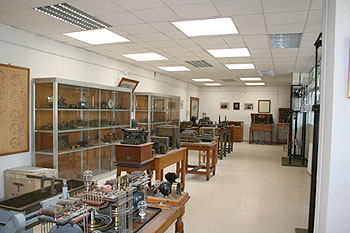Leonardo Torres Quevedo was born on 28 December 1852, on the Day of Holy
Innocents, in Santa Cruz de Iguña (Cantabria), Spain. His family lived, most of
the time, in Bilbao, where Torres' father worked as railway engineer. They also
spent long periods at his mother’s family house way up in mountains of
Santander. In Bilbao he studied to enter in an advanced high school program and
later spent two years in Paris in order to complete his studies. In 1870, his
father was transferred, bringing his family to Madrid. The same year, Torres
Quevedo began his higher studies in the Official School of the Civil
Engineering. He completed his studies in 1876, as the 4th best
student in his promotion.
He began his career in the same train company for which his father had
worked, but then immediately set out on a long trip round Europe in order to
familiarize himself with the last scientific and technical advances of those days,
especially in the newly spawn sector of electricity. When he returned to Spain,
he settled in Bilbao where he financed his own work and began a study and research
lifestyle he never gave up. He married in 1885 and eventually had eight
children.
In 1885 he constructed a funicular in Molledo (Santander). In 1887 he
patented a multiple cable funicular (cable car). His patent presented a system
of cables that were tightened by counterbalances in a controllable and uniform
way, so that if a wire would break, it would not endanger the whole structure.
 Later, in 1907, he constructed the Monte Ullía funicular, in San Sebastian,
the first for public use.
Later, in 1907, he constructed the Monte Ullía funicular, in San Sebastian,
the first for public use.
These cable cars were just a test of the one that would at last grant him
world fame: The Niagara River Spanish Aerocar, built in 1916 over the Niagara
River in Canada (in the place known as “The Whirlpool”).
In 1893 he presented a report in Madrid, concerning how to solve algebraic
equations in a mechanical way. Since then, Torres Quevedo constructed several
analogical calculating devices. In 1899 he moved to Madrid and became involved
in the city's cultural life. In 1902 he published, in Spain and France, his blimp
innovating project.
Building a blimp with a semi-rigid frame, he conquered the problems of the
rigid structured aircrafts had been having so far; he had created a flying
machine that could at last compete in better terms than the widely popular Zeppelin
blimps.
In 1905, thanks to the help of Captain A. Kindelan, he built a small
model blimp in the military facilities of Guadalajara. In 1909 he patented
another improved blimp model and offered it to the French company Astra, that
in 1911 began its serial manufacturing. During World War I the Astra blimp was widely
used by the allied forces.
In 1903 he patented the remote control system named "Telekine".
The system was a first remote control device conceived to control blimps from the
ground. The idea was to avoid risking lives during test flights, but the “Telekine”
was never installed in an actual blimp. It was, though, used in various test,
the most famous of which had it steering a small boat in the port of Bilbao
(1906).
 In 1912 he presented "Chessplayer Automaton", the first chess
computer with electrical relays which, played a king and a rook, against a lone
king controlled by a human opponent. It could then checkmate a human opponent in
a non-optimal, but still impressive number of moves. A second one was built in
1920. That same year he presented in Paris one of the first truly digital
calculators: the “Electromechanical Arithmometer”. The device was connected to
a typewriter in order to input data, and would print the solution on the same
paper the data was written on through its own automatic mechanical means.
In 1912 he presented "Chessplayer Automaton", the first chess
computer with electrical relays which, played a king and a rook, against a lone
king controlled by a human opponent. It could then checkmate a human opponent in
a non-optimal, but still impressive number of moves. A second one was built in
1920. That same year he presented in Paris one of the first truly digital
calculators: the “Electromechanical Arithmometer”. The device was connected to
a typewriter in order to input data, and would print the solution on the same
paper the data was written on through its own automatic mechanical means.
the Laboratory of Applied Mechanics was created as a consequence of the
work he carried out during these years. He was named its director in the year
1901. The Laboratory was specialized in the manufacturing of all sorts of scientific
instruments and equipment. Among the notable achievements the lab reached, Gonzalo
Brañas’s cinematographer and Cabrera and Costa’s X-Ray spectrograph, are two
important examples.
In 1901 Torres-Quevedo was invited to enter the Royal Academy of Exact,
Physical and Natural Sciences in Madrid. He was elected president of the
institution by 1910. In 1916 King Alfonso XIII bestowed the Echegaray Medal
upon him. In 1920, he joined the Royal Spanish Academy, in the seat that had
been occupied by Benito Pérez Galdós, and became a member of the department of
Mechanics of the Paris Academy of Science. In 1922 the Sorbonne named him an
Honorary Doctor and, in 1927, he was named one of the twelve associate members
of the Academy.
Torres Quevedo died in Madrid, in the heat of the Spanish Civil War on 18
December 1936, ten days before of his eighty-fourth birthday. A great man had died, but his inventions and legacy live on.




